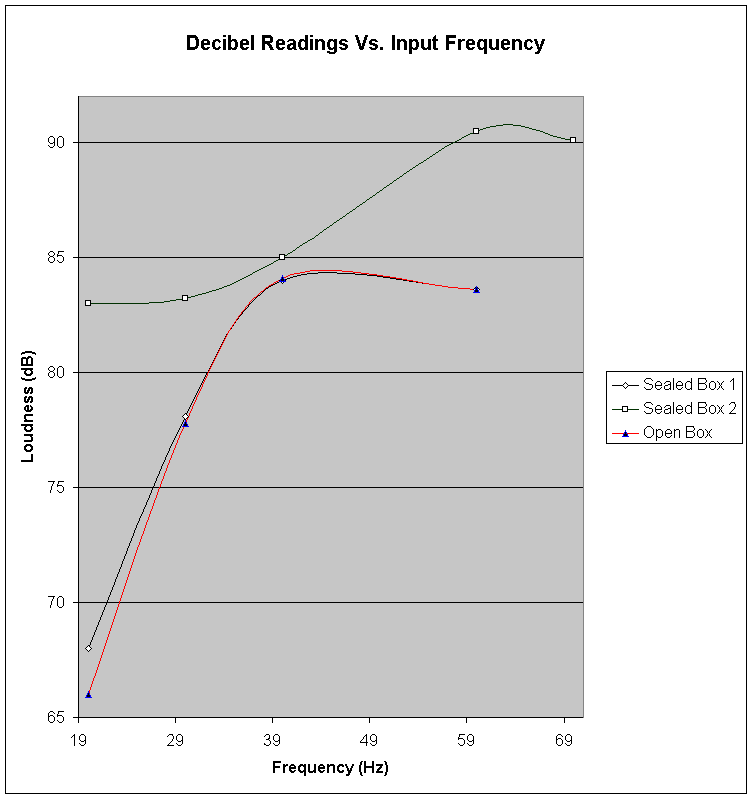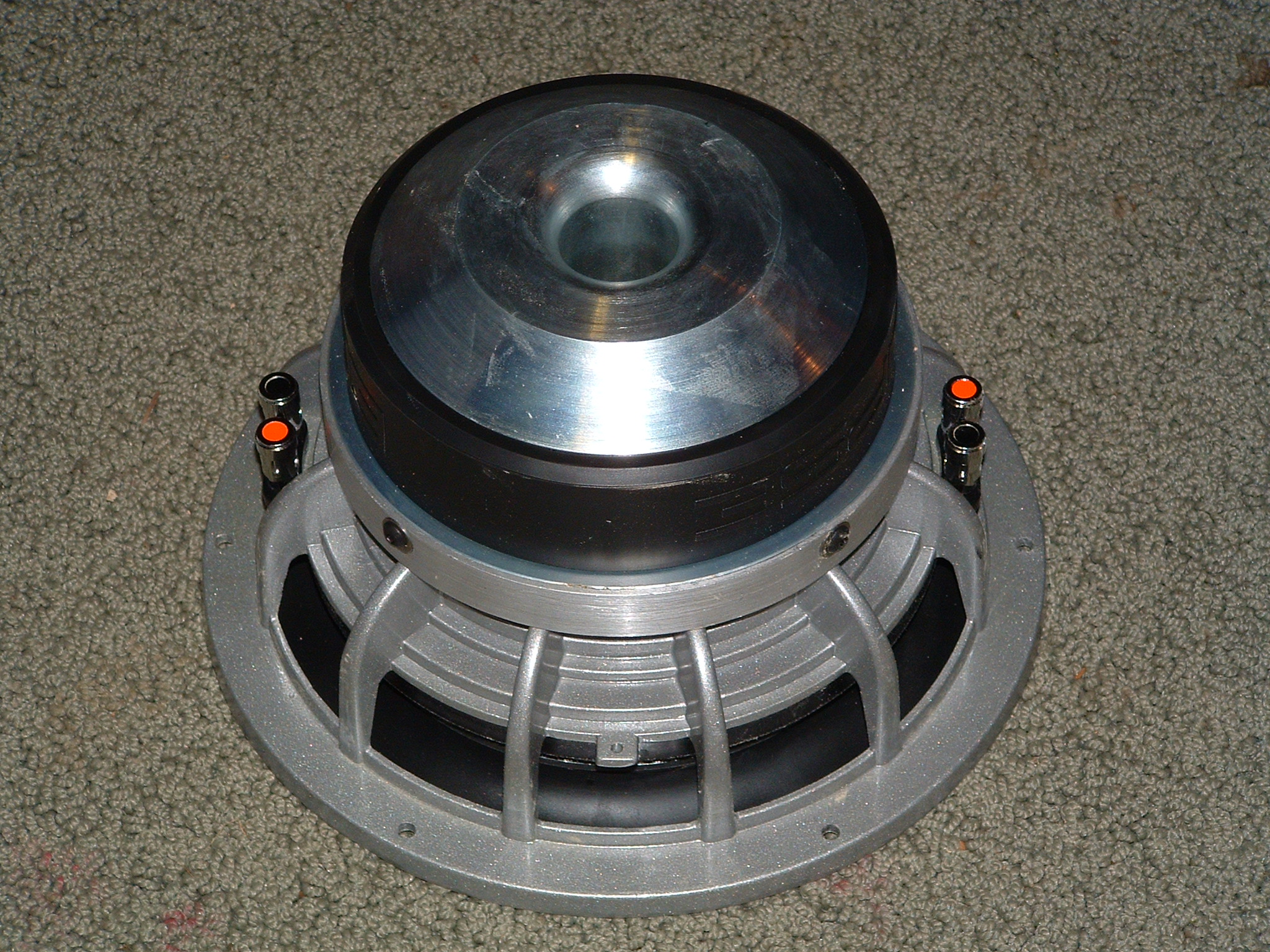Nick Bocchi
Nate Schneider
Subwoofer
Enclosures
Statement of the Hypothesis Lab Materials Lab Set-up Procedures
Analyses/Margin of Error Background Conclusion Sources And Links
Back To 2002-2003 IB Research Projects
-Statement
of the Hypothesis-
·Subwoofer 10”
Eclipse Aluminum cone Dual Voice Coil @ 2
Ohms
·Amplifier Alpine MRD-300 (200 Watts RMS @11.9 volts
·Decibel measuring device
·Frequency generator
·Battery or source
·Positive and negative wiring for subwoofer
·Signal to amplifier
·Board for construction of box (Box 1= Low density fiberboard, Box 2 =
high density fiberboard)
·Elmers wood glue to bind boards together
·Screws to secure the structure
·PVC piping
·Insulating foam
The main objective of our experiment was to measure the loudness (dB) of the subwoofer within its enclosure. To accomplish this we had to obtain a device to generate controlled frequencies, a speaker to generate those frequencies, and an amplifier and battery to power our lab set up. When first brain storming conceptual ideas for our lab set up we designed a subwoofer box that would have a specific internal volume and a piping set up that would allow the subwoofer box to be used as a ported (opened) or sealed box. With this initial box design we made a circular cut out in the face of the box to set the subwoofer in.
With the wiring from the subwoofer coming out of the through a small insulated whole cut in the side of the box, we then configured the Dual Voice Coils on the speaker to present a 2 ohm load to the mono amplifier. Also attached to the amplifier was our frequency generator that was used to generate low frequencies of 20Hz, 30Hz, 40Hz, 60Hz, 70Hz, any higher hertz didn’t make much difference in output. The amplifier supplied ~200 watts of continuous wattage to the subwoofer on 11.9 volts of power.
With the given set up of our lab above, we went about connecting our devices and placed the subwoofer within it enclosed box inside a garage. Then with another individual’s amplifier and car battery, we pulled the back of their car up backwards to the garage. After activating the battery to power our amplifier we adjusted our frequency generator to input 20hZ, 30 Hz, 40 Hz, 60 Hz, 70 Hz. With the decibel reading device directly in front of the subwoofer we generated the frequencies and recorded the loudness of which they were projected. To assure that the generated frequencies were the only sounds sensed by the decibel-reading device, we recorded our results when no other humanly audible sounds we present or interfering with our experiment. Also, when we originally began recording our data, we had a problem with the subwoofer box vibrating across the ground. In fear that these vibrations would affect our results, we placed a mess on top of the box to prevent it from moving about. TOP
Although out data collection was relatively simple, elements of our experiment could have been fine-tuned. The environment that the testing took place could have been quieter in order to insure a perfect test. We tested outside and many little things could have registered on the decibel meter that wasn’t being produced by the speaker. With proper funding we could have constructed an insulated room that would deflect and absorb and outside noise, vibrations, or any other external forces that could influence the data that we collected.
In addition more sensitive equipment could have been used that would allow more accurate data collection and analysis. Overall our experiment procedure was relatively simple and allowed clear data to be collected with our controlled variables. TOP
Subwoofers are a very important part of the audio range. In most car audio applications, subwoofers usually do not sound as good as they should. When producing high amounts of bass with subwoofers in car audio, many users encounter problems in sound quality. There are many different variables that can weaken or add to the system that produces low-frequency waves in sound systems. Variables such as power supply, woofer construction, and most importantly, enclosure design.
When designing subwoofer enclosures, three types of enclosures are commonly used to mount, utilize, and maximize the subwoofers surface area in order to create different characteristics of low-rage bass. Commonly used are sealed, ported, or band pass subwoofer enclosures. Many variables such as materials, port lengths and diameter, and cubic volume within the box, will alter sound quality, loudness, and efficiency of the bass system. Sealed boxes (enclosures) offer a deep, precise bass output. Ported boxes produce a more forceful bass.
A sealed box is an airtight enclosure housing the subwoofer. It is the best for any music that demands tight, accurate bass. Expect a flat response (not excessively boomy), deep bass extension, and good power handling (efficiency). A sealed enclosure tends require more power than a ported box because it must do work on the volume of air sealed within the enclosure when it has a positive and negative excursion.
A ported box uses a vent (called a port) to reinforce low bass
response. More output is produced
from a ported box in comparison to a sealed box at any given amplifier
wattage. Some people prefer the sound of
ported boxes for rock, heavy metal, or any hard-driving music.
Ported boxes can deliver deeper bass than sealed boxes, give even
better efficiency, although they need to be much larger than sealed enclosures
to accomplish that. TOP
The purpose and goal for this Research Project is to discover the
differences in loudness created by a subwoofer in different types of
enclosures. The procedure used to
demonstrate the properties of the different boxes will include measuring the
output of the speaker in decibels. By comparing the results of both enclosures
at different frequencies (within 20Hz to 100Hz) we will be able to determine
which box will be the loudest. TOP
|
Hertz |
Sealed
Box 1 1.20 Cubic feet. |
Ported
Box (same as box 1) |
Sealed
Box 2 .66 Cubic feet. |
|
|
|
66.0dB
|
83.0dB
|
|
|
|
|
83.2dB
|
|
|
|
77.8dB |
85.0dB
|
|
|
|
84.1dB
|
90.5dB
|
|
|
|
83.6dB
|
90.1dB
|


Alden, Ray. Advanced Speaker Designs for the Hobbyist & Technician.
Delmar Learning , September 1996.
Alden Ray- This book, although quite out of date, provides many high cost and high labor subwoofer enclosure designs mainly focusing on home theater acoustics.
Basic Car Audio Electronics: Basic Enclosure Calculations
<http://www.eatel.net/~amptech/elecdisc/spboxnew2.htm>
Basic car audio – This is the most informative website
dealing with car audio on the entire internet.
We spent countless hours reading topics that other website often wouldn’t
even mention.
http://www.crutchfieldadvisor.com/S-lHGTXSrPCZy/learningcenter/car/subwoofers_enclosures.html
A very concise/basic website briefly describing the differences of the most common subwoofer enclosure types.
Pettitt, Joe. How to Design and Install High
Performance Car Stereo: A Beginners Guide to High Tech Auto Sound Systems.
CarTech Inc. Agust 1996
Pettitt- Mostly a book that teaches car audio to dummies. It only touches on subwoofers and amplifiers for a few pages.
Weems, David B. Designing, Building, and Testing Your Own
Speaker System with Projects. McGraw - Hill/TAB Electronics 4th edition.
November 1, 1996.
This car stereo web page is more for basic information about box enclosure designs. It would not be helpful if you were looking for technical information on the physical principles of the boxes.
http://www.carstereo.com/?ref=rayfes
This is an interesting web site that offers a program to gather data on a particular box design of your choice.
http://www.geocities.com/SiliconValley/Hills/1924/speaker_building.htm
This web page offers interesting data on decibel readings and other information on a speakers parameters.
http://www.loudspeakers101.com/SealHelp.htm
